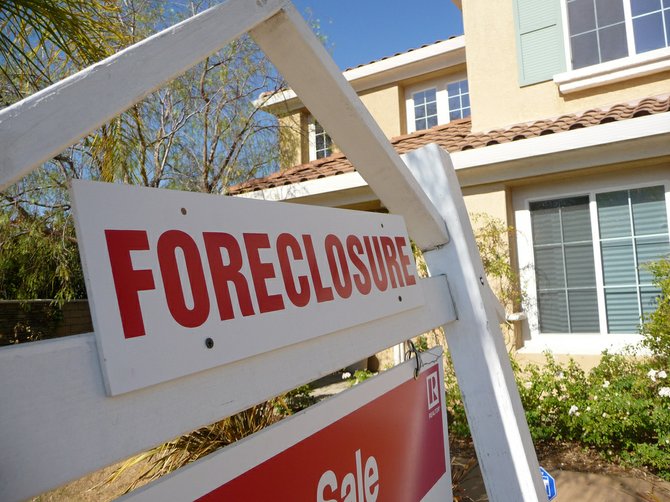Even in the sixth year of the foreclosure crisis, the country remains saddled with an extraordinarily high number of loans in foreclosure. Photo by Jeffrey Turner
Over the past several years, we've reported extensively on the big banks' foreclosure failings. As a result of banks' disorganization and understaffing—particularly at the peak of the crisis in 2009 and 2010—homeowners were often forced to run a gauntlet of confusion, delays, and errors when seeking a mortgage modification.
But while evidence of these problems was pervasive, it was always hard to quantify the damage. Just how many more people could have qualified under the administration's mortgage modification program if the banks had done a better job? In other words, how many people have been pushed toward foreclosure unnecessarily?
A thorough study released Aug. 30 provides one number, and it's a big one: about 800,000 homeowners.
The study's authors—from the Federal Reserve Bank of Chicago, the government's Office of the Comptroller of the Currency (OCC), Ohio State University, Columbia Business School, and the University of Chicago—arrived at this conclusion by analyzing a vast data set available to the OCC. They wanted to measure the impact of HAMP, the government's main foreclosure prevention program.
What they found was that certain banks were far better at modifying loans than others. The reasons for the difference, they established, were pretty predictable: The banks that were better at helping homeowners avoid foreclosure had staff who were both more numerous and better trained.
Unfortunately for homeowners, most mortgages are handled by banks that haven't been properly staffed and thus have modified far fewer loans. If these worse-performing banks had simply modified loans at the same pace as their better performing peers, then HAMP would have produced about 800,000 more modifications. Instead of about 1.2 million modifications by the end of this year, HAMP would have resulted in about 2 million.
That's still well short of the 3-4 million modifications President Obama promised when he announced the program back in early 2009. But it's a big difference, and a reasonable, basic benchmark against which to compare the program's failings.
The report does not identify these poor performing banks, but it's not hard to ID them. A "few large servicers [have offered] modifications at half the rate of others," the authors say. The largest mortgage servicers are Bank of America, JPMorgan Chase, Wells Fargo and Citi.
Bank of America in particular (the largest of all the servicers when HAMP launched) has been far slower to modify loans than even the other large servicers, as other analyses we've cited have shown.
Rick Simon, a spokesman for Bank of America, said the banks' "home retention results are significant and in line with our industry peers to date."
The Home Affordable Modification Program (HAMP) paid subsidies to mortgage servicers on the theory that doing so would convince them to embrace modifications. The authors say that voluntary approach apparently didn't have much effect with the biggest servicers. They weren't very good at modifying loans before HAMP was launched and weren't much better after it launched.
The authors wrote that while they can't be sure why these banks underperformed, they "may not have responded to the program since doing so would involve changing their business focus from processing and channeling payments to actively renegotiating loans. In addition, this may have involved significantly altering their organizational capabilities, such as building appropriate infrastructure and hiring and training servicing staff."
That echoes on our reporting on how ill-suited the big banks were when it came to modifying loans. The result inside the banks has sometimes been chaos. As one Bank of America employee complained, "The whole documentation collection thing has got to be purposely not funded. Like, I can't get a fax. I work for a huge bank that has tons of money, and you're telling me that I can't get a fax?"
Since HAMP's oversight has been lax—the Treasury Department, which runs the program, has responded indulgently to mortgage servicers breaking HAMP's rules—banks haven't had to worry much about their low modification rates. (You can see this explained with a song. It's also a big part of our book on the foreclosure crisis.)
A Treasury spokeswoman, responding to the new report, said HAMP had resulted in "one of the most comprehensive compliance reviews of mortgage servicing operations in the country. Servicers in the Making Home Affordable Program are subject to an unprecedented level of compliance oversight."
The report did have some positive findings concerning HAMP. As we've reported, modifications in the program have been more generous to homeowners than modifications done outside HAMP. The authors also found that the program did boost the number of modifications—i.e. it caused modifications that likely would not have happened if not for the program.
The authors also say that HAMP might have induced more modifications if the program had not required such extensive screening of homeowners seeking a modification. From the program's launch, the administration emphasized that the program wouldn't help the wrong sort of "irresponsible" homeowner. That emphasis led to requirements that homeowners send in lots of paperwork to prove their income, which in turn further taxed the big servicers' inadequate systems.
Despite the recent stabilization in home prices and a drop in the rate of homeowners falling behind on their payments, HAMP's limited impact remains a very relevant issue. Even in the sixth year of the foreclosure crisis, the country remains saddled with an extraordinarily high number of loans in foreclosure—about 2 million. That backlog hasn't improved much in the last couple years, meaning it's still hard to forecast when the foreclosure rate will return to a normal level.



Comments
Use the comment form below to begin a discussion about this content.
comments powered by Disqus